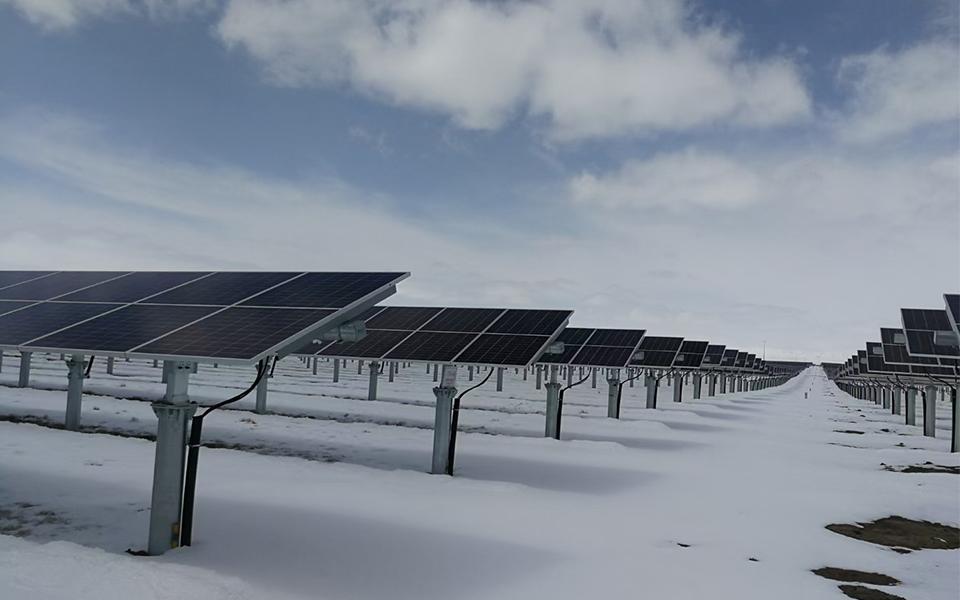
According to the ETO, the contribution of solar to Chinese domestic electricity production will increase from 5% today to 38% by 2050, and new solar power installations will account for 58% of all new electricity generation capacity additions between now and the end of this decade.
Should China expand its solar sector as DNV is predicting, by 2050, it will have a mammoth 3.9TW of solar PV capacity, alongside 1.6TW of solar-plus-storage capacity, giving the Chinese solar sector a total installed capacity north of 5TW.
Storage is expected to play an increasingly vital role in the Chinese solar sector, too, with DNV estimating that, by 2050, 34% of all new Chinese solar capacity additions will be co-located with storage products, to help mitigate the variability inherent to renewable power generation.
Ultimately, if DNV’s predictions are accurate, China’s energy mix will almost be completely reversed by 2050, with the contribution of fossil fuels to domestic energy generation expected to fall from 66% today to 7% in 26 years’ time, while non-fossil fuels will account for 55% of electricity generation by 2050.
A key driver of this change, and a well-documented aspect of China’s solar sector, is the low levilised cost of electricity (LCOE) in the solar industry. Ensuring renewables are an attractive investment destination for financiers is a key aspect of realising the global energy transition, and solar is already considerably cheaper in China than other power sources.
DNV reports that the LCOE of solar PV is currently around US$39/MWh, the lowest among all fuel options in the power sector, and even solar-plus-storage, which boasts a much higher LCOE of US$75/MWh, is lower than any fossil fuel-based option. The analyst expects this trend to continue, forecasting the LCOE of solar PV to fall to US$24/MWh and the LCOE of solar-plus-storage to fall to US$44/MWh by 2050.
Supportive funding and policy
A combination of considerable investment and supportive government policy have been crucial to expanding the Chinese solar sector in this manner, according to DNV.
The analyst reports that, in 2023, China committed US$890 billion to the clean energy sectors, including solar power, electric vehicles and batteries – a figure that would make up the majority of the US$1.8 trillion that Bloomberg New Energy Finance reported as being invested into clean energy worldwide in 2023.
China also leads the world in public sector energy research investment, with the government committing an average of US$4-6 billion annually into new technologies, and the 14th Five-year Plan, implemented in October 2020, to increase energy research and development spending by 7% annually.
“The growth in solar has been largely driven by subsidised electricity prices (in the form of feed-in tariffs or FITs) for renewable energy,” explain the report’s authors, suggesting that there are factors beyond sheer volume of capital behind this encouragement to invest.
“As part of FITs mechanism, solar and wind firms were offered a guaranteed price above market for their electricity. Since FITs greatly reduced the risks associated with the novel technology, this policy measure attracted many new developers into solar industry.
“The success of the FITs policy has been a dramatic decrease in the costs of solar energy, which is already now the most economical form of energy in China on a LCOE basis.”
The country’s solar sector has expanded greatly since the implementation of the 14th Five-year Plan, which aimed to install 1.2TW of wind and solar generation capacity by 2030.
This programme has also sought to decarbonise China’s energy mix as a whole – aiming for non-hydro renewables to account for 18% of the country’s power consumption by 2025 and renewables to account for one-third of the country’s power consumption by the same year – and decrease carbon emissions per unit of GDP by 65% by 2030, compared to 2005 levels.
On a more local level, other policies have encouraged individual companies and grids to minimise their carbon footprints. In 2021, state-owned enterprises were required to meet half of their energy needs with renewables by 2050, and in the same year, new grid connection legislation required electricity generated by renewable sources to account for at least half of the power transmitted by newly-constructed grid lines.
Grid investments
DNV also expects China to invest considerably in its grid infrastructure, among growing concerns that a lack of availability of grid connections could be a critical obstacle to the acceleration of the energy transition. The analyst reports that in 2023, the State Grid Corporation of China invested US$77 billion into transmission infrastructure, a record figure 4% higher than in the previous year, and DNV expects this investment level to double by 2032.
The capacity of China’s distribution grid is expected to almost treble over the next 26 years, increasing from 56 terawatt-kilometres (TW-km) to 134TW-km between the present day and 2050.
Part of this capacity increase will be driven by efficiency improvements in existing grid infrastructure, but much will be owed to considerable lengths of new cables set to be laid, with DNV expecting grid length to grow by around 2.7% year-on-year from 2022 to 2050.
This will translate to a growth in the length of China’s distribution grid from 24 million circuit-kilometres (c-km) in 2022 to 51c-km by 2050, more than double the length currently in operation.
Remi Eriksen, president and CEO of DNV, explained in the report’s introduction that many of these changes are motivated by a desire for China to reach a degree of energy independence, for which parallel investments in power generation, storage and distribution will be required across China.
“Energy independence is the key motivation behind China’s energy policy,” wrote Eriksen. “We find that this is only partly achieved by mid-century, when China will still be importing sizeable quantities of oil and gas. In our view, there is potential for China to accelerate its transition to reduce its reliance on these sources further and faster — and to bring China closer to net-zero emissions by 2050.”





